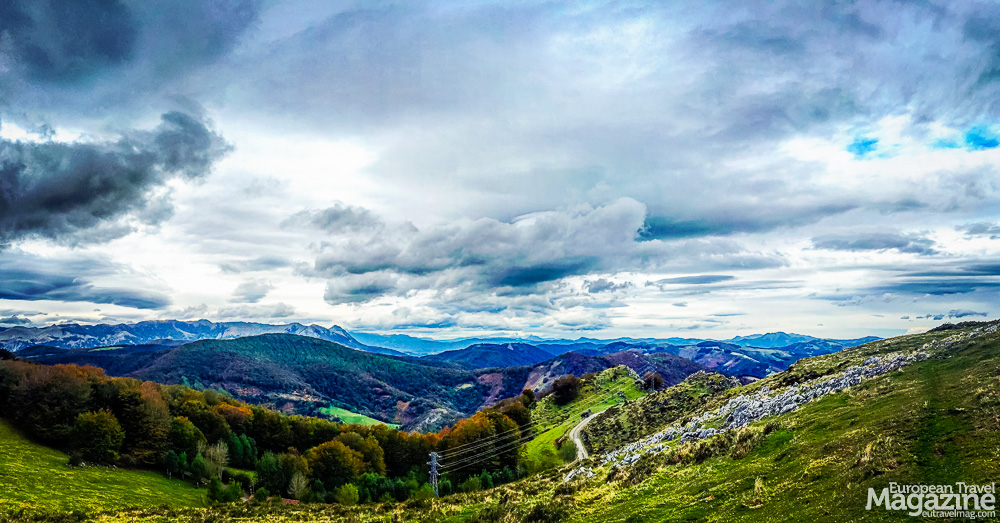By Georgina Howard, Pyrenean Experience
Zugarramurdi is a rustic Basque village, snuggling in the foothills of the western Pyrenees. While the name Zugarramurdi is quite innocent and means “hill of elm trees”, the village is nowaday far better known for its caves and witches than for its hills and elms, because this is the site of the most brutal witch hunt of the Spanish Inquisition.
In 1610, after imprisonment and torture in the dungeons of Logroño, 53 people from the Zugarramurdi area were accused of witchcraft during the infamous Auto-da-fé – the largest witch trial in history.
A series of events that led up to the witch trials are well documented (and explained below). However, the more interesting question is: WHY did this tragedy fall upon Zugarramurdi, a presumably peaceful, Basque village of only a few hundred people, tucked away in the misty borderlands of the Pyrenees?
Medieval tourist guide
As early as 1140, Aymeric Picaud wrote the Codex Calixtinus, the first “tourist guide” to the Camino de Santiago, and this gave the Basque people of neighbouring Navarra a pretty bad reputation. In it Picaud described them as “fierce-faced men who terrorize people with their barbarian tongues”, going on to describe the Basque people as “full of evil, dark in complexion, of aberrant appearance, wicked, treacherous, disloyal and false”. (He even went on claiming that the food was awful, and with the best of our knowledge about Pintxos, that’s a downright lie!).
- The Basque countryside is monumental, mysterious and majestic
- Carnival in Ituren, where men dressed like the abominable snowman walk with bells of their back. Photo courtesy of pyreneanexperience.com
- The Basque woods DO feel mysterious and full of ancient widsom
- Basque cuisine was criticised by Picaud in medieval times, but “Pintxos” are small “tapas” from heaven!
Consequently it is easy to understand why pilgrims, crossing the Pyrenees for the first time, would have been filled with fear. They would have found murky weather, a terrain filled with dark forests, dotted with isolated villages full of strange, weathered, distinctive-looking people of an alien cultural background and speaking an odd, harsh-sounding language. This sudden contrast would only serve to reinforce Picaud’s profile of the Basque people. However misguided this may have been, the image persevered throughout the centuries.
Stillborn children and cursed mothers
Other elements can be added to the ill-fated reputation of Zugarramurdi.
Firstly, it was everyday practice among the locals to make remedies, creams and brews from a wide variety of mushrooms and plants found in those mountains. Secondly, in the 16th century, villages like Zugarramurdi were predominantly female because many of the men were away for months at a time working on the whaling boats along the Basque coast.
Secondly, in the 16th century, villages like Zugarramurdi were predominantly female because many of the men were away for months at a time working on the whaling boats along the Basque coast.
Thirdly, and perhaps more delicate, the Basque population have a very high percentage of Rhesus Negative blood that caused (and still causes) many children to be stillborn. This would probably have lead them to being considered cursed!
For some uneducated people it was but a small step to imagine that Zugarramurdi was filled with witches and pagan worshippers.
The Spanish Inquisition, eternally eager to locate and expel infidels from Spain, needed very little encouragement.
And it came.
The Witch Trials
It came in the form of a young 20-year-old girl returning to Zugarramurdi after living several years in France. Not only did she tell everyone that she had participated in Akelarres (Witches’ Sabbaths) but she accomplished to convince the villagers that another woman from Zugarramurdi, Maria de Jureteguia, had participated in them as well. Bit by bit people started accusing each other of witchcraft: it was witches who sent the storms, killed people, ruined harvests and had sexual relationships with the devil, who appeared to them in the form of a ram.
- The Basque woods tell a tale of a forgotten yore
- The countryside is full of picturesque places
- A young girl returning to Zugarramurdi after living several years in France claimed that she had participated in Akelarres (Witches’ Sabbaths). Photo courtesy of pyreneanexperience.com
- The Pyrenees are especially beautiful in autumn
The village priest, realising that matters were getting out of hand, swiftly and sensibly tried to put an end to it all by saying that, if people were prepared to come to church and confess to being witches, they would be pardoned and the case would lie to rest. This may have been so had the Abbot from the Monastery of Urdax, greedy for recognition, not had other ideas. He chose to send the so-called “witches of Zugarramurdi” off on an over 100 kilometre journey to Logroño to ask for a formal pardon from the Spanish Inquisition itself.
That moment changed the fate of this tiny, unknown “village of elm trees”. Imagine the sight of a band of people arriving in the cosmopolitan town of Logroño, dressed in their strange mountain attire, speaking their unintelligible language, dirty and wretched after their long journey. And then, on arrival, for them to knock on the doors of the Spanish Inquisition to proclaim that they had once been witches and were now asking for forgiveness! Not only was forgiveness denied them, but they were thrown into the dungeons, providing the Inquisition with the perfect trophy for their efforts. Inquisitors were immediately dispatched to hunt down the witches of Zugarramurdi and to find out what “in hell” was going on!
The jails slowly filled with increasingly more people from the Zugarramurdi area and on November 7th 1610, after fifteen months of torture, the famous witch trials of Logroño took place. Fifty-three people were accused of witchcraft and the trials were witnessed by some 30.000 people.
Twenty-one penitents were dragged through the streets, bare-headed, with large wax candles in their hands. Another twenty-one people walked behind them wearing sanbenitos (a tunic worn by supposed sinners). At the end of the procession, five people carried a representation of those who had died in prison, together with their remains in coffins, destined to be burned. At the end of the line came four women and two men, condemned to be burned alive for having continued to deny that they were witches.
Witch fever
Triggered by these events, thousands of people all over the country were being accused of witchcraft and the madness and witch fever was slowly getting out of hand. Although the objective of the Inquisition was to cleanse the country of heretics and propagate Christianity, having a mob of Christian people accusing each other of witchcraft was counter-productive to the cause!
It was at this point that the Spanish Inquisition turned to the help of Alonso de Salazar Frías. He visited the region of Zugarramurdi and, after 18 months of talking with the local people, came to the conclusion that the majority of the accusations were false. He believed, that it was the priests’ sermons on devils and witches, that were the main reason for people believing there were witches in their midst and concluded, that the best way to put an end to witchcraft was to stop speaking about it! With this the number of witches reduced dramatically and the witch hysteria slowly subsided.
- The Basque people still live in harmony with nature and traditions. Photo courtesy of pyreneanexperience.com
- The Cave of Zugarramurdi is said to be home to the occult rituals. Photo courtesy of pyreneanexperience.com
- Image of Christ can be found on many houses of the devout. or maybe it’s a lesson learned.
- To this day, the Basque don’t do well with authorities. No wonder.
Today the very interesting museum on the witches of Zugarramurdi, the Museo de las Brujas (link to Spanish website), tells the tale and is well worth a visit. Afterwards, a stop at the Cave of Zugarramurdi, that was said to be home to the occult rituals, is an ideal place to let the story sink in and your imagination fly.
Georgina Howard is a Brit-turned-Basque teacher and writer, living in the bewitching Basque countryside for over 20 years now. With her enterprise Pyrenean Experience, she opens her home a limited number of times each year for Hiking Holidays, Spanish Language Immersions and for everyone eager to learn more about the Basque country and culture.
Learn more














